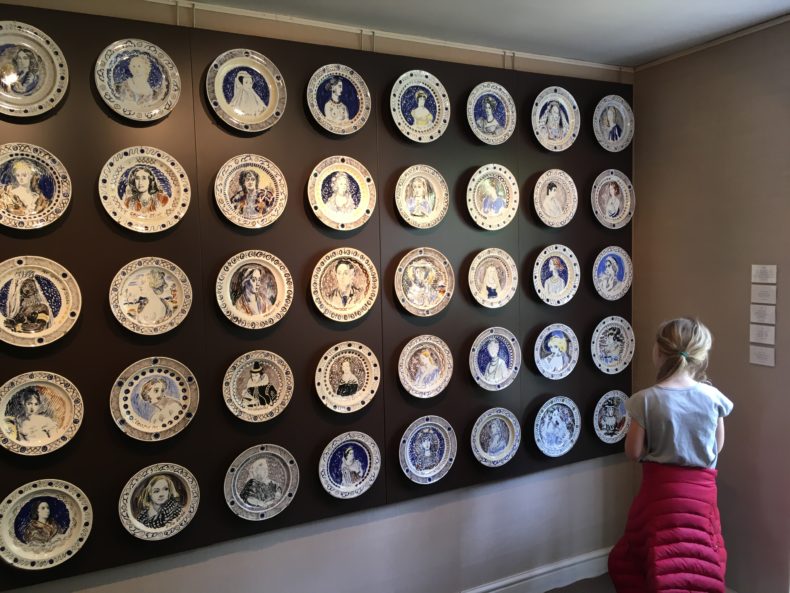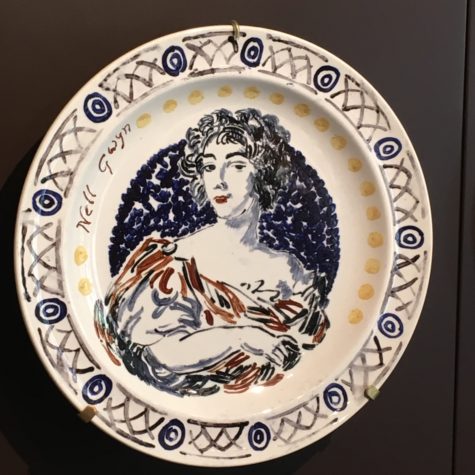 “It’s like Good Night Stories for Rebel Girls, but on dinner plates,” I told my nine-year-old daughter during a recent trip to London. She wasn’t entirely convinced, but she agreed to go with me and a friend to see the long-lost Famous Women Dinner Service, a set of 50 plates painted by the artists Vanessa Bell and Duncan Grant.
“It’s like Good Night Stories for Rebel Girls, but on dinner plates,” I told my nine-year-old daughter during a recent trip to London. She wasn’t entirely convinced, but she agreed to go with me and a friend to see the long-lost Famous Women Dinner Service, a set of 50 plates painted by the artists Vanessa Bell and Duncan Grant.
Plates! I know: boring. But I promise you, as I promised my daughter, that these plates are not boring. Here’s their story.
In 1932, the British museum director Kenneth Clark and his wife Jane ordered an elaborate dinner service from Bell and Grant, central figures in the Bloomsbury Group and lifelong creative partners. The Clarks gave the artists a great deal of latitude, but they were evidently surprised when Bell, in a letter to Jane Clark, reported that “our idea is to make it an illustration of women in different capacities—famous queens, actresses & so on … We could have classical figures or modern or anything.” As Kenneth Clark would later delicately acknowledge, the service “turned out differently to what we had expected.”
The portraits, on Wedgwood plates, are divided into sets of twelve “Beauties,” “Queens,” “Dancers and Actresses,” and “Women of Letters.” (The  remaining two portraits are of Bell and Grant themselves, each painted by the other). Some of the women represented are still famous enough for my daughter to recognize on sight—Elizabeth I, Cleopatra, Jane Austen—while others, such as Miss America 1933, were stars of their time. The roster ranges from antiquity to the present and far beyond Europe, and its members reflect the enthusiasms of Bell, Grant, and others in their set—especially of Bell’s sister, Virginia Woolf, who has a plate of her own. Among the “Women of Letters” are Austen, Charlotte Brontë, Christina Rossetti, the Lady Murasaki Shikibu, and Elizabeth Barrett Browning, all of whom Woolf admired. To my daughter’s delight, Browning is pictured with her spaniel, Flush, whose perspective Woolf adopted in her own portrait of the poet.
remaining two portraits are of Bell and Grant themselves, each painted by the other). Some of the women represented are still famous enough for my daughter to recognize on sight—Elizabeth I, Cleopatra, Jane Austen—while others, such as Miss America 1933, were stars of their time. The roster ranges from antiquity to the present and far beyond Europe, and its members reflect the enthusiasms of Bell, Grant, and others in their set—especially of Bell’s sister, Virginia Woolf, who has a plate of her own. Among the “Women of Letters” are Austen, Charlotte Brontë, Christina Rossetti, the Lady Murasaki Shikibu, and Elizabeth Barrett Browning, all of whom Woolf admired. To my daughter’s delight, Browning is pictured with her spaniel, Flush, whose perspective Woolf adopted in her own portrait of the poet.
The Clarks might have been surprised by the theme of their new dinner service, but they surely knew to expect the unexpected, for Bell and Grant were rebels in many senses. “Nessa,” Woolf once wrote of her sister, “seems to have slipped civilisation off her back, and splashes about entirely nude, without shame, and enormous spirit.” Bell and Grant shared a home in Sussex for more than forty years, a wildly unconventional household that welcomed, at various times and to varying degrees, Bell’s husband Clive and their two sons, Julian and Quentin; Bell and Grant’s daughter, Angelica; Clive Bell’s mistress, Mary Hutchinson; and Grant’s predominantly male lovers. Angelica, who grew up believing that Clive Bell was her biological father, eventually married David Garnett, with whom Grant had had an extended affair when he and Garnett were conscientious objectors during World War I.
As artists, Bell and Grant moved back and forth between representation and abstraction, and between fine and decorative work. They adorned the Cambridge office of economist John Maynard Keynes with a set of large, fanciful portraits of the Muses, and covered the interior of their Sussex house, Charleston, with bold patterns and bright colors.
While the details of Bell and Grant’s domestic situation weren’t part of my daughter’s pre-tween tour, she did appreciate that neither they nor the women they painted cared much for what other people thought. Writers George Eliot and George Sand were strikingly androgynous; Queen Christina of Sweden dressed as a man, and was said to have female lovers; Nell Gwyn, the mistress of Charles II, was renowned for her acting at a time when female performers were equated with prostitutes; Marie-Anna de Camargo, an 18th century French ballerina, drew both admiration and criticism for her rejection of traditional costumes, and for her dazzlingly athletic leaps. Princess Pauline von Metternich of Austria took part in an “emancipated duel” with a countess in 1892, allegedly to settle an argument over arrangements for a music and theater exhibition (the duel, conducted with rapiers, was called off after blood was drawn).
By including these and other taboo-breaking women in the Clarks’ dinner service, Bell and Grant didn’t so much rescue them from obscurity as seat them alongside the uppermost upper crust of British society. It was a bit of mischief that Kenneth Clark, despite his initial misgivings, seems to have enjoyed: in later years, he is said to have selected particular plates for particular lunch guests at his Piccadilly apartments—perhaps to honor their interests, or to prick their sensitivities.
The dinner service survived the wartime bombing of London and several moves by the Clarks, but their descendants eventually sold the plates to a private collector. For decades, almost no one in the art world knew where the service was, or even if it still existed, and the Famous Women were largely forgotten, known only by a few surviving studies and sketches. Judy Chicago, whose monumental 1979 installation “The Dinner Party” arranged place settings for 39 mythical and historical women, including Woolf, around a triangular table, was apparently unaware of Bell and Grant’s work until long after her own domestic reimagining became a classic of feminist art.
Last year, however, shortly before the opening of an exhibition of Bell and Grant’s work at the Piano Nobile gallery in Holland Park, the current owner of the plates contacted the gallery, and its astonished directors confirmed that the set remained complete and undamaged. The Charleston Trust is raising money in hopes of bringing the service back to Bell and Grant’s longtime home, which is now open to the public; in the meantime, all 50 plates are displayed on a wide, low wall toward the back of the small gallery, with the plates portraying Bell and Grant at the center of the set. The day my daughter and I visited, her initial impatience faded quickly, and we looked at the plates for a long time—examining the faces of the famous and not-so-famous, and wondering which rebel girls Bell and Grant would include today.